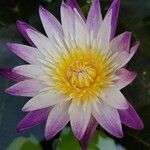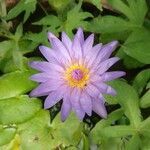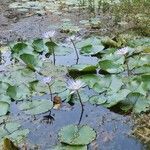Aquatic, rhizomatous, perennial herb, rooted in bottom mud. Leaves spirally arranged, ovate to almost circular, floating, palmately veined, basal lobes slightly overlapping to widely diverging, margins entire, wavy or bluntly toothed; long-petioled. Flowers solitary, showy, long-pedunculate, held up to 0.3 m above water. Sepals green to whitish with rose-pink apex (var. caerulea) or blue to purple (var. zanzibariensis). Petals 12-24, violet-blue or reddish, sometimes pink or white, grading into stamens. Stamens 30-100, outer with broad petaloid filaments, anthers yellow, blue or purple, opening by longitudinal slits, introrse. Ovary sunk in receptacle, syncarpous, many-locular; ovules many per locule. Flowering time Aug.-Mar. Fruit a large berry. Seeds many, sinking to bottom and germinating when aril decays.
A herb which grows in water and keeps growing for several years. It is about 1.5 m high. The rhizomes or underground stems are erect and unbranched. The leaves arise from the base of the plant and are very large with few teeth around the edge. The leaves are shaped like an arrowhead. They are green on the upper surface and reddish on the lower surface. Leaves are 13 cm long and 7-10 cm wide. They can be 45 cm across. They are on long stalks. The flowers are slightly above the water. The flowers are very large with white petals tinged with pink or yellow. The flowers are 8-18 cm across. There are 10-30 petals. The fruit are fleshy. They are round and 1.5-4.5 cm across. There are many seeds inside. The seeds are oval or round and 0.5-1.3 mm across. They have rows of hairs along them.
Annual or perennial; rhizome erect, globose, tuberous, to c. 3 cm diam. Leaf lamina c. 10–23 cm wide, slightly sinuate. Flowers barely emergent. Sepals 4, usually to 3 cm long, rarely to 7 cm long, acute, with purple streaks usually near margins. Petals to c. 10, lanceolate, acute, blue, pink or white; gap between petals and stamens present. Stamens to c. 20; filaments flattened, tough, to 11 mm long; anthers to 8 mm long; sterile appendage to 7 mm long. Carpels 7 or 8; sterile stigmatic lobes to 4 mm long. Fruit c. 1.5–4 cm diam. Seeds c. 0.75 mm diam., with continuous rows of long hairs.
Aquatic perennial with floating leaves, woolly below. Leaves orbicular, deeply notched at base, margins undulate or scalloped, petioles long or short. Flowers blue, scented, closing at night.




